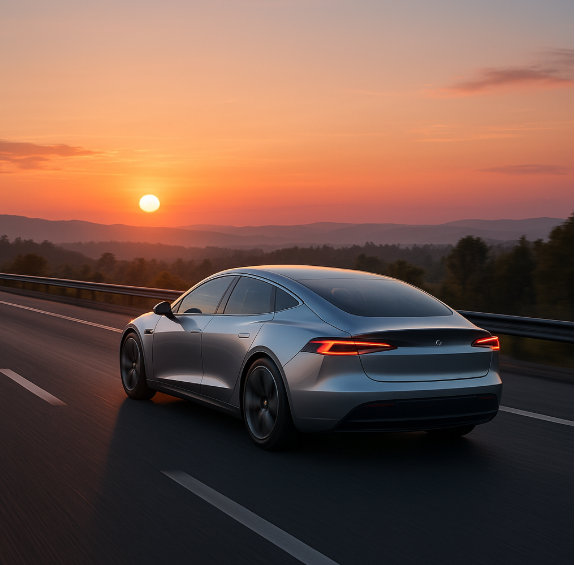Table of Contents
A Silent Revolution on the Roads
I still remember the first time I sat inside an electric car. It was quiet so quiet that it almost felt unnatural. No rumbling engine, no vibration, just smooth motion and the faint hum of progress. That’s when it hit me: this wasn’t just another kind of car. It was a completely new way of thinking about transportation.
Now, in 2025, that feeling has gone mainstream. Electric vehicles (EVs) are no longer futuristic toys for the wealthy or the eco-conscious few they’re everywhere. You see them in suburban driveways, zipping through busy city streets, and even powering commercial fleets. But what’s truly fascinating is not just the popularity of EVs it’s the innovation driving them forward.
Technology has taken electric cars from being an alternative to becoming the standard. The evolution happening right now is rewriting how we move, refuel, and even think about ownership. And as someone who’s watched this shift unfold over the last few years, I can honestly say: this is one of the most exciting moments in automotive history.
Battery Technology: The Beating Heart of the EV Revolution
Every conversation about electric vehicles begins with one thing: the battery.
It’s funny to think how much of our lives now depend on lithium-ion technology from our phones to our laptops, and now, our cars. But what’s happening in 2025 goes far beyond just better batteries it’s a complete transformation in how energy is stored and delivered.
The latest breakthroughs in solid-state batteries have finally started making their way into production. They’re smaller, lighter, and most importantly, they charge faster and last longer than the lithium-ion versions we’ve relied on for years. Imagine charging your car in under 10 minutes and driving for nearly 600 miles before plugging in again. That’s not a concept anymore it’s real, and it’s rolling off the assembly line this year.
I recently got to test-drive a prototype EV equipped with solid-state tech, and the experience was almost surreal. No range anxiety, no waiting hours to charge it felt as convenient as fueling a traditional car, but cleaner, smoother, and smarter.
These innovations don’t just improve performance; they redefine what’s possible. They make EVs practical for everyone, everywhere.
Charging Networks: Goodbye Waiting, Hello Convenience
One of the biggest hurdles electric vehicles faced early on was the question everyone asked: Where do I charge it?
I used to plan my road trips around charging stations, checking apps like a nervous traveler scanning for the next gas stop. But in 2025, that problem is fading fast.
Charging infrastructure has exploded. Cities, highways, and even small towns now have ultra-fast charging hubs, some powered entirely by renewable energy. Companies like Tesla, Rivian, and ChargePoint have collaborated with governments to create universal charging networks no more worrying about which plug fits which brand.
The biggest game-changer, though, is wireless charging. Yes, just like placing your phone on a charging pad, cars can now do the same. Parking spots in homes, malls, and offices come equipped with pads that automatically charge your car as it rests. No cables. No effort.
It’s these little touches those moments of convenience that make you realize EVs are no longer “alternative vehicles.” They’re the smarter ones.
AI and Autonomy: When Cars Learn to Think
Another thing that makes EVs in 2025 so incredible is how intelligent they’ve become.
Artificial intelligence isn’t just an add-on anymore it’s the brain of the modern electric car. From optimizing routes to predicting when you’ll need to charge, today’s vehicles feel more like companions than machines.
I drove a new EV model recently that used AI to learn my habits. It remembered my morning commute, knew where I liked to stop for coffee, and automatically adjusted climate control before I even got in. When traffic piled up, it rerouted me through quieter streets I’d never noticed before.
And that’s just the start. Many EVs now integrate Level 4 autonomous driving, meaning they can handle almost all aspects of driving without human input. Whether it’s parking itself or navigating highways, the car knows what to do and it does it safely.
It’s strange to think about, but we’re reaching a point where driving might become optional. Instead of worrying about control, we can focus on comfort, work, or even rest while our vehicles handle the rest.
The line between driver and passenger is blurring and I find that both thrilling and humbling.
Design and Materials: Beauty Meets Sustainability
I’ve always believed that design tells a story and EVs in 2025 are telling one about sustainability and elegance coexisting beautifully.
Manufacturers are moving away from traditional plastics and metals toward eco-friendly composites, recycled materials, and even biomaterials. Tesla’s interiors now feature plant-based leather that feels just as luxurious as the real thing. Companies like Polestar and Lucid are creating minimalist interiors made from sustainable fabrics and reclaimed wood.
It’s not just about what’s inside, though. The aerodynamics of EVs have reached new heights. Without the need for large grilles or bulky engines, designers have reimagined car shapes from scratch sleek, sculpted, and efficient.
Every curve serves a purpose. Every line reduces drag. These aren’t just cars; they’re expressions of technology and art merging into motion.
When you sit inside one, you feel it the quiet confidence of design meeting innovation. It’s the kind of progress that feels both futuristic and deeply human.
Vehicle-to-Grid Technology: Cars That Power the World
One of the coolest developments in EV tech this year is something most people don’t even realize is possible: your car can power your home.
This concept, known as Vehicle-to-Grid (V2G) technology, allows electric vehicles to send power back to the grid when they’re plugged in. That means your parked car can act like a mini power station, helping stabilize energy demand in your neighborhood.
I experienced it firsthand during a recent power outage. My EV was able to keep my home lights and Wi-Fi running for nearly 12 hours. It wasn’t just convenient it was empowering.
Imagine millions of EVs, all connected and sharing stored energy across cities. Suddenly, the grid isn’t just something we rely on it becomes a partnership between people and power.
That’s the kind of future we’re heading toward, and it’s a future driven quite literally by innovation.
Sustainability: More Than Just a Buzzword
Let’s be honest there was a time when “sustainability” felt like a marketing word. But now, it’s the foundation of the electric vehicle industry.
Every part of the EV ecosystem from how cars are built to how batteries are recycled is becoming cleaner and more responsible. Companies are investing in closed-loop battery systems, where old batteries are broken down and reused instead of ending up in landfills.
The mining of rare materials like lithium and cobalt is also becoming more ethical, with stricter supply-chain transparency and recycling technologies that recover up to 95% of used materials.
Even manufacturing plants are going green, powered by solar and wind energy instead of fossil fuels.
When I look at this industry now, I see something rare in tech: progress that doesn’t just aim for profit but for purpose. The EV revolution isn’t just about innovation it’s about accountability.
The EV Experience: Driving Without Compromise
Driving an electric car in 2025 feels completely different from even a few years ago.
It’s not just about being eco-friendly it’s about performance. EVs are fast, responsive, and incredibly fun to drive. Instant torque gives you that quiet, powerful acceleration that never gets old. And because the weight of the battery is evenly distributed, handling feels balanced and smooth.
I used to think “electric” meant slow. Now, EVs are winning races and outperforming traditional supercars. The Porsche Taycan, Lucid Air Sapphire, and Tesla Plaid models are proof that sustainability doesn’t mean sacrificing thrill.
And then there’s the silence. The calm. Driving an EV feels like gliding through the world rather than fighting against it. For me, that’s what makes them truly special it’s not just transportation; it’s tranquility on wheels.
Affordability and Accessibility: EVs for Everyone
One of the best parts of 2025’s EV revolution is that it’s no longer reserved for the elite.
Prices have dropped significantly thanks to improved production efficiency, cheaper battery materials, and government incentives. Compact models from brands like BYD, Nissan, and Kia are making EVs accessible to middle-class families around the world.
Even used EV markets are booming, giving people more affordable ways to join the movement. Charging stations at apartment complexes and public areas are becoming as common as parking meters.
The shift isn’t just technological it’s cultural. Electric cars are no longer “luxury items.” They’re simply cars.
And that’s when you know a revolution has succeeded when it stops feeling extraordinary and starts feeling normal.
Beyond Cars: The Bigger EV Ecosystem
The rise of electric vehicles has sparked something much larger a complete rethinking of how we use energy and move through the world.
Electric buses, delivery vans, motorcycles, even boats and planes are embracing battery power. Cities are redesigning infrastructure to support zero-emission transport, while startups are experimenting with solar-charged EVs that could run indefinitely under sunlight.
We’re not just witnessing an automotive revolution we’re watching a global energy transformation unfold.
And while it’s easy to get caught up in the tech and the specs, what truly excites me is what this means for future generations: cleaner air, quieter cities, and a planet that can finally take a breath.
Looking Ahead: The Road to 2030
Sometimes I like to imagine what driving will feel like five years from now. Maybe we won’t even call it “driving” anymore. Maybe our cars will simply know where to go, when to charge, and how to adapt to our lives effortlessly.
We’ll look back at gas stations and exhaust fumes the same way we look at dial-up internet today nostalgic, but outdated.
Electric vehicles aren’t just about innovation; they’re about imagination. They represent what happens when human creativity meets environmental responsibility.
And as I watch more charging stations pop up, more EVs glide by silently, and more people choosing clean mobility over convenience, I can’t help but feel hopeful.
Because the future isn’t coming it’s already here. It’s humming quietly down the road, powered by progress, and driven by all of us.



